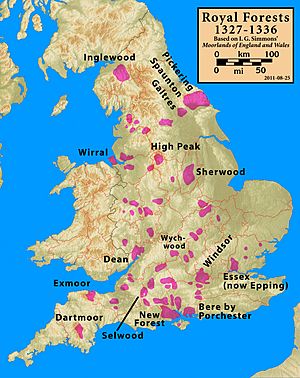Selwood Forest facts for kids
The ancient Selwood Forest was a huge woodland area in England. It stretched roughly between Gillingham in Dorset and Chippenham in Wiltshire. During the Anglo-Saxon period, which was a very long time ago, Selwood Forest was like a giant natural wall. It was a very important boundary between the eastern and western parts of Wessex, an old Anglo-Saxon kingdom.
This forest might have also been a border between Wessex and another old kingdom called Dumnonia. Its location was key in shaping the areas that later became the counties of Wiltshire and Somerset, and parts of north Dorset. Even today, some of the old county lines still run through where the forest once stood.
Contents
Selwood as a Boundary
Selwood Forest was known as a significant boundary for many years. In 705 AD, its importance was recognized when a new church area, called a bishopric, was created in Sherborne. This new bishopric was specifically for people living "west of Selwood." This shows how the forest naturally divided the land and the people living there.
A Royal Dispute
In 855 AD, King Æthelwulf decided to go on a special trip, called a pilgrimage, to Rome. He left his son, Æthelbald, in charge as king while he was away. However, when King Æthelwulf returned the next year, Æthelbald refused to give up the throne.
A writer named Asser, who didn't approve of Æthelbald's actions, wrote that Æthelbald and his supporters planned this takeover "in the western part of Selwood." We don't know exactly why they did this. One reason might have been that nobles from the western part of Wessex felt that King Æthelwulf was showing too much favor to the eastern part of his kingdom, especially to the city of Winchester.
Alfred the Great's Stand
Selwood Forest also played a big role in the story of Alfred the Great. In 878 AD, Alfred gathered his army to fight against the Great Heathen Army, which was a large group of Viking warriors.
According to Asser's book, Life of King Alfred:
- Seven weeks after Easter, King Alfred rode to a place called Egbert's Stone.
- This stone was located in the eastern part of Selwood Forest.
- There, people from Somerset, Wiltshire, and Hampshire joined him. Many people from Hampshire had stayed because they were afraid of the Vikings.
- This gathering in Selwood was a crucial moment in Alfred's fight to protect his kingdom from the Vikings.
Later Mentions in History
The Anglo-Saxon Chronicle, which is a very old historical record, also mentions Selwood. In 893 AD, it describes how English forces gathered to fight another Viking attack.
The Chronicle states that important leaders and the king's soldiers gathered from many fortified towns. They came from areas:
- East of the River Parrett
- Both east and west of Selwood
- North of the River Thames
- West of the River Severn
- Even some Welsh people joined them.
This shows that Selwood was still a well-known landmark used to describe where people were coming from across the land.
Selwood's Changing Importance
In the tenth century, Wessex was divided into two main areas, each led by a powerful noble called an ealdorman. Selwood Forest marked the boundary between these two areas.
However, Selwood's importance as a boundary changed around 1020 AD. This was when Godwin was made the earl of all of Wessex. With one person in charge of the whole kingdom, the forest no longer served as a dividing line between different parts of Wessex.
Selwood Today
Today, most of the ancient Selwood Forest is gone. Only a few small areas of ancient woodland still exist from the medieval period. These remaining parts are not very large. One example of a surviving area is Picket Wood near Yarnbrook. These small woodlands are a reminder of the vast forest that once covered this part of England.


